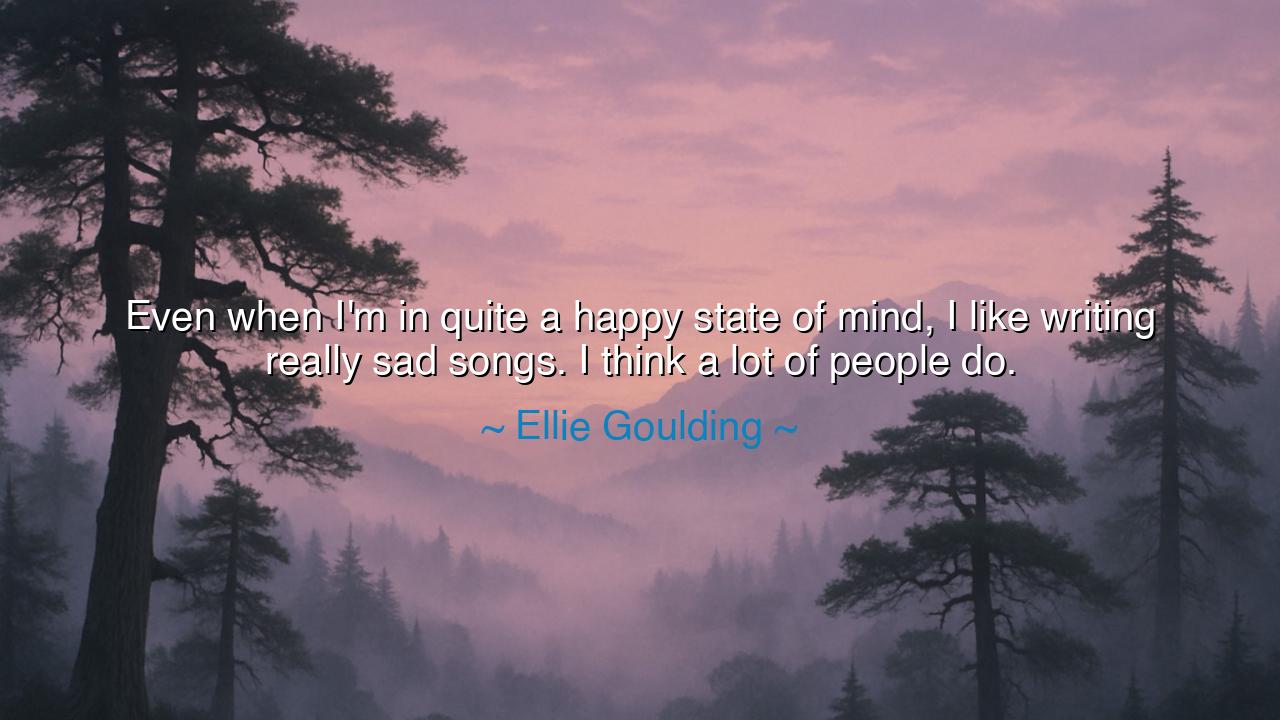
Even when I'm in quite a happy state of mind, I like writing
Even when I'm in quite a happy state of mind, I like writing really sad songs. I think a lot of people do.






Hear the words of Ellie Goulding, lighthearted yet filled with hidden truth: “Even when I’m in quite a happy state of mind, I like writing really sad songs. I think a lot of people do.” At first glance, these words may puzzle the unreflective, for why should one write of sorrow while the heart is filled with joy? Yet here lies one of the oldest mysteries of art: that sadness, when transformed into song, becomes not a burden but a release, not a wound but a healing.
For music has always been the vessel of human emotion, and the greatest songs are often born from sorrow. A person who writes a sad song while happy is not betraying their joy, but honoring the truth that sadness dwells always beneath the surface, waiting to be spoken. Goulding reveals a secret that many creators know: we write sad songs not to multiply despair, but to give form to emotions that cannot live silently within us. This act is both catharsis and connection, binding the singer to the listener in shared humanity.
The ancients themselves knew this paradox. The Greeks revered tragedy above comedy, believing that to confront sorrow in art was to purify the soul. They gathered in amphitheaters not to laugh away their troubles, but to weep together at the stories of Oedipus and Antigone. From their grief, they drew strength. Likewise, in every age, songs of loss, longing, and lament have endured, because they allow us to face pain safely, and in facing it, to transform it.
History, too, gives us luminous examples. Consider Billie Holiday, whose haunting voice carried the sorrow of a people. Her song “Strange Fruit,” though filled with unbearable pain, became an anthem of awakening and remembrance. She did not sing it only in moments of grief—she sang it always, as a way of bearing witness. In the same way, Goulding’s admission reminds us that the act of writing sad songs is not about one’s current mood, but about honoring the eternal human condition, which weaves joy and sorrow together.
The deeper meaning is this: sadness in art is not the enemy of happiness. It is its companion, its shadow, its necessary counterbalance. To write a sad song while happy is to acknowledge that life is not one color but many, that joy is sweeter because sorrow exists, and that sadness, when expressed through music, becomes something beautiful rather than something crushing. Thus, the artist becomes a healer, taking grief and shaping it into something that can be carried by others without despair.
The lesson for us is to embrace the full range of emotion. Do not fear sadness, nor suppress it. Express it, sing it, write it, paint it—transform it into something that gives life. At the same time, when joy is upon you, do not cling to it selfishly; let it inspire you to reach into sorrow and turn it into art, so that others may feel less alone. In this balance lies the true power of creation.
So let us take Goulding’s words as a teaching: that sad songs are not merely for the broken-hearted, but for all who live, for all who feel, for all who wish to connect with the deepest currents of the soul. To create from sadness is to honor truth; to listen is to be reminded that our grief is shared. Thus the work of the artist becomes not only personal but universal—an eternal bridge between hearts.






AAdministratorAdministrator
Welcome, honored guests. Please leave a comment, we will respond soon